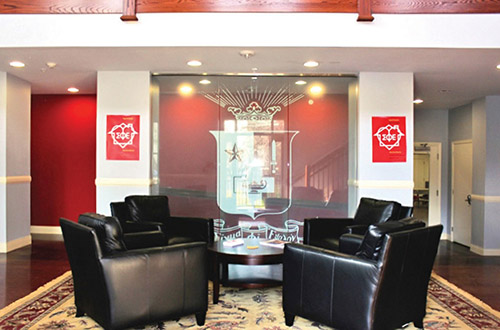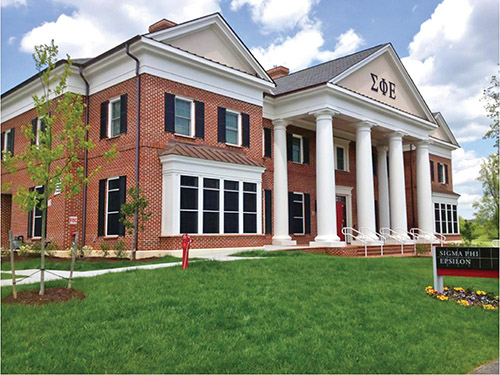
Great architecture and thoughtful design can change the way we see ourselves. These elements can inspire us and elevate the expectation for achievement. The ideal SigEp chapter home does just that.
Consider the fact that the typical student spends 90 percent of his college experience outside a formal classroom setting, and the importance of an exceptional living-learning environment becomes even clearer. Across the country, SigEp’s Alumni and Volunteer Corporations ensure that chapter homes demand excellence through their design. Projects can vary from cosmetic updates to major renovations, from safety upgrades to new construction. What remains consistent is the hard work, thoughtful approach and brotherly love that goes into maintaining homes capable of developing high-achieving balanced men.
At the 54th Grand Chapter Conclave, SigEp National Housing recognized two AVCs for their dedication to facilities that provide brothers with a superior environment in which to live, learn and prepare for the journey of life ahead.
“Fraternity house of the future” opens its doors at Cincinnati
As reported in the fall 2014 issue of the Features, a solution for Cincinnati’s aging house presented itself when the chapter’s Alumni and Volunteer Corporation was able to purchase and expand onto adjacent land. Their expansion sought to provide a living-learning community that could rival all other student housing options, rather than simply making necessary upgrades.
The now-complete, 18,000-square-foot house not only provides the comforts of home, but also the optimal setting for blending academic and social pursuits. Members can study quietly in the house library or get together for group work in the Alumni Recognition Room. There is also a chapter room that doubles as a 150-seat classroom. University-accredited courses will be offered in the space each spring. SigEp faculty fellow and dean of the university’s Clermont College, Jeff Bauer, Wright State’88, led the initial class last semester. Approximately 24 students enrolled in Bauer’s microeconomics course, which was offered to SigEps and members of a select group of campus sororities.
AVC President Rey Medina, Cincinnati ’99, said most of the first floor has been designated as study and classroom space. However, with nine wireless access points throughout the house, and high-speed Internet in all the bedrooms, any comfortable spot is a potential study area.
The resident scholar’s living and office spaces can also be found on the first floor. Graduate student John Georgeson, Cincinnati ’15, is the first resident scholar to call the new Ohio Theta facility home. One of his primary duties is to organize a speaker series for members. The fall 2015 series focused on study skills and was presented by Georgeson and SigEp faculty fellow Ric Sweeney, Cincinnati Renaissance.
In total, Ohio Theta has four faculty fellows who hold office hours at the house. Along with Bauer and Sweeney, they include Paul Nodzak, assistant professor of biological sciences, and Scott Steger, Cincinnati ’93, academic adviser and assistant director of enrollment management. The faculty fellows make themselves available to provide academic guidance, and they frequently drop in to socialize and build relationships with brothers. Medina noted that informal mentoring relationships often develop as a result.
In addition to the opportunity to get to know faculty outside the classroom, Medina observed that the new house helps members socialize with each other more. The communal use of the new space can be seen in activities such as “Man Cave Mondays,” when Georgeson hosts a chapter-wide study session in the basement. The house also boasts a weight room, and brothers schedule time weekly to work out as a group.
The entire expansion and renovation process took only seven months to finish from the time construction began. Such outstanding results would not have been possible if not for the overwhelming alumni enthusiasm for the project and the AVC’s well-run capital campaign. The drive brought in $1.3 million, including a $50,000 commitment from the undergraduate chapter. When the doors to the new Ohio Theta facility opened, alumni and volunteers realized their vision for a house that would be a place to both connect and grow intellectually.
A new home and a new chapter for Virginia Tech

Alumni of SigEp’s Virginia Tech Chapter know the importance of supporting a complete fraternity experience. With this goal in mind, volunteers set out to build a new $5 million Residential Learning Community. Structural challenges made the chapter’s previous house of more than 40 years, a converted five-bedroom residence in Blacksburg, Va., incapable of sufficient renovation. But as construction and fundraising got under way, alumni-volunteers were confronted with the harsh reality that the undergraduate chapter’s culture had also deteriorated beyond repair.
In May 2013, the Virginia Kappa Chapter closed for the first time in its history.
Alumni set their focus on building a new chapter culture suited for the new facility. The AVC immediately went to work preparing for the chapter’s fall 2015 return, and the capital fundraising campaign continued as alumni further increased their investment.
AVC members also wanted to make sure the ideals of scholarship and personal growth would be practiced in the home. Fundraising Campaign Chairman John Lawson, Virginia Tech ’75, said the group researched the latest teaching and residential learning concepts. He and fellow volunteer Don McNamara, Virginia Tech ’75, helped spearhead the AVC’s initial partnership with the university and worked diligently to strengthen it over the past two years.
Alumni-volunteers spent countless hours on campus and recruited three faculty fellows from the Myers-Lawson School of Construction: Brian Kleiner, the school’s director, and construction engineering professors Bob Muir and Josh Iorio. AVC housing director William Thomas Jr., Virginia Tech ’72, said the faculty members will be fixtures in the life of the chapter. They are spending time getting to know members and developing curriculum for the Residential Learning Community (they plan to apply for accreditation in 2017). Later, they’ll hold classes in the house and support the chapter’s Balanced Man Program with input from Virginia Tech’s director of leadership education, Heather Evans.
For now, the chapter uses the house for some chapter and AVC meetings as well as some recruitment events. When the recolonization process is complete, the chapter will return to a house that provides distinct areas for living, learning and socializing. The three-story home approaches 20,000 square feet and contains approximately 6,800 square feet of communal space.
Flexibility is a key part of the facility’s design. For instance, the chapter meeting room contains a drop-down screen and projector system that can be utilized in a classroom setting. The same room can be converted into a dining room for special events. Classes can also be held in the facility’s conference and recreation rooms, while a library and quiet study rooms double as spaces for smaller seminars. Brothers will also benefit from live-in mentors, as the space provides housing for both a resident scholar and a full-time house director who will oversee day-to- day property management.
The university provided two-thirds of the construction costs, and alumni have committed $1.7 million. The goal is to push well past $2 million and use additional funds to support scholarship and academic programming. At Conclave, the Virginia Kappa AVC was celebrated for their outstanding accomplishments in the face of adversity and their unwavering commitment to the highest ideals of the Fraternity.









Leave a Reply